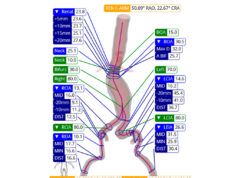
A single-centre, retrospective study reveals that approximately 11% of patients diagnosed with lung cancer concurrently have an abdominal aortic aneurysm (AAA). Researchers theorise dual screening could save lives.
There is significant overlap in the populations screened for lung cancer and AAA. The US Preventive Services Task Force (USPSTF) recommends annual screening for lung cancer in patients aged 50–80 years who have a 20 pack-year smoking history and currently smoke or quit within the past 15 years. The USPSTF suggests one-time screening for AAA for men aged 65–75 years who have a history of smoking. Further identification of groups at high risk for AAA would improve the effectiveness of screening and hopefully save lives, researchers suggested.
“Lung cancer and AAA each carry substantial morbidity and mortality, and because smoking is a predominant risk factor for both diseases, they are innately linked,” said principal investigator Brody Wiles (Stony Brook University, New York, USA). “This led us to question if changes in screening strategies might prevent morbidity and mortality from AAA.”
The findings were published in the March 2021 edition of the Journal of Vascular Surgery. Researchers queried cases from 2001 to 2017 from Stony Brook School of Medicine’s Lung Cancer Program database. For all patients with lung cancer, they reviewed the whole-body positron emission computed tomography (CT) scan at the time of diagnosis for the presence of AAA.
A total of 814 lung cancer patients with a mean age of 67 years (47% male, 53% female) were included in the study. Comparing with a non-lung cancer control group matched for age and sex, the researchers found the prevalence of AAA to be:
- 11% in cancer patients vs.
- 2% in controls (p=0.0001).
Characteristics of the AAA cohort included:
- 76% were infrarenal,
- 8% had previous AAA repair,
- 4% were >5.5cm and unrepaired, and
- 77% had early stage (1 or 2) lung cancer.
“In this study, after removing those who had a previous AAA repair, one in 10 patients had an AAA, and one in 200 had an aneurysm meeting the criteria for treatment,” said Wiles. “Most of the AAA patients had early-stage disease associated with survival rates ranging from 53–92%, suggesting a potential mortality benefit for aneurysm repair.”
Because of the high incidence of AAA in patients with lung cancer, it may prove worthwhile to screen patients simultaneously for the two diseases, said researchers. With this in mind, Wiles noted, “If the field of view in low-dose CT scanning for lung cancer is extended only 12–13cm caudally, the entire infrarenal aorta would be screened for aneurysm.”
There are no previous studies documenting such a high prevalence of AAA in a cohort of lung cancer patients and the idea of simultaneous screening is novel, the researchers said.
Wiles concludes, “Our findings suggest further prospective studies should focus on examining the survival benefit of screening for AAA at the same time as lung cancer screening. If a reduction in mortality is shown in such studies, changes in screening guidelines should be made to include screening for AAA in populations not currently screened, such as women and non-smokers.”
Click to read the full article.













